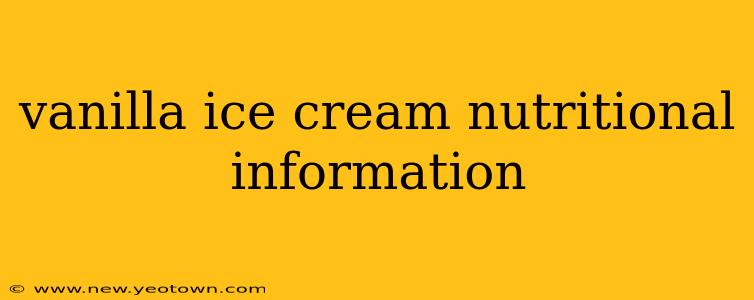Vanilla ice cream. The classic dessert. A comforting scoop on a hot day. But have you ever stopped to consider what's actually in that creamy delight? Let's unravel the nutritional information behind this beloved treat, exploring everything from fat content to sugar and beyond. This isn't just about numbers; it's about understanding what you're consuming and making informed choices.
What are the Macronutrients in Vanilla Ice Cream?
The macronutrient breakdown of vanilla ice cream varies considerably depending on the brand, the type (e.g., premium vs. light), and even the serving size. However, we can look at a general profile. A typical half-cup serving often contains a significant amount of fat, primarily saturated fat. This fat contributes to the rich, creamy texture we all love. It's also a source of energy, but consuming excessive amounts of saturated fat can have implications for heart health. The carbohydrate content is largely due to sugar, either added sugars or naturally occurring lactose from the milk. Protein content is generally moderate, coming from the milk solids. Precise figures will always be found on the product's nutrition label.
How much sugar is in vanilla ice cream?
This is a key question, and the answer is: it depends! Added sugars are a major contributor to the sweetness and can significantly impact the overall sugar content. Some brands opt for less added sugar, while others rely on it more heavily for flavor. Reading the nutrition label is crucial here to gauge the added sugar per serving and compare across different brands. Remember that excessive sugar intake is linked to weight gain, dental problems, and other health concerns. Look for options that minimize added sugars, and consider portion control to manage your sugar intake.
How many calories are in a scoop of vanilla ice cream?
Again, this depends! A standard scoop (approximately 1/2 cup) can range anywhere from 100 to 200 calories or more. The calorie count is directly influenced by the fat and sugar content. Higher-fat ice creams will naturally have more calories. If you're watching your calorie intake, opting for lower-fat versions or smaller portions can make a difference. Always check the nutrition label for the specific calorie information for the brand you’re considering.
Is vanilla ice cream healthy?
This is a complex question with no simple "yes" or "no" answer. In moderation, as part of a balanced diet, a small scoop of vanilla ice cream isn't inherently unhealthy. However, regularly consuming large quantities can contribute to weight gain, due to its calorie and sugar content. The ingredients used – like added sugars, artificial colors, and stabilizers – also influence its overall health profile. Opting for brands with higher-quality ingredients and lower added sugars can help make it a more healthful choice, albeit still a treat rather than a staple.
What are the ingredients in vanilla ice cream?
The core ingredients typically include milk or cream, sugar, and vanilla extract. However, many commercial brands also include stabilizers, emulsifiers, and other additives to enhance texture, shelf life, and flavor. Reading the ingredient list on the packaging provides a clear picture of what’s in your ice cream. Pay attention to any artificial ingredients or excessive amounts of added sugars.
Are there healthier alternatives to vanilla ice cream?
Absolutely! Several options provide a healthier twist on this classic dessert. Greek yogurt-based ice creams often offer a higher protein content and lower fat. Sorbet, made with fruit and often without dairy, is naturally lower in fat and calories. Homemade ice cream gives you complete control over the ingredients, allowing you to adjust sweetness and fat levels to your liking, opting for natural sweeteners and healthier fats.
This detailed look at vanilla ice cream nutrition highlights the importance of reading labels, understanding portion sizes, and making informed choices. Enjoy your ice cream, but do so mindfully, as part of a balanced and varied diet. Remember that a treat is just that—a treat, not a daily necessity.

